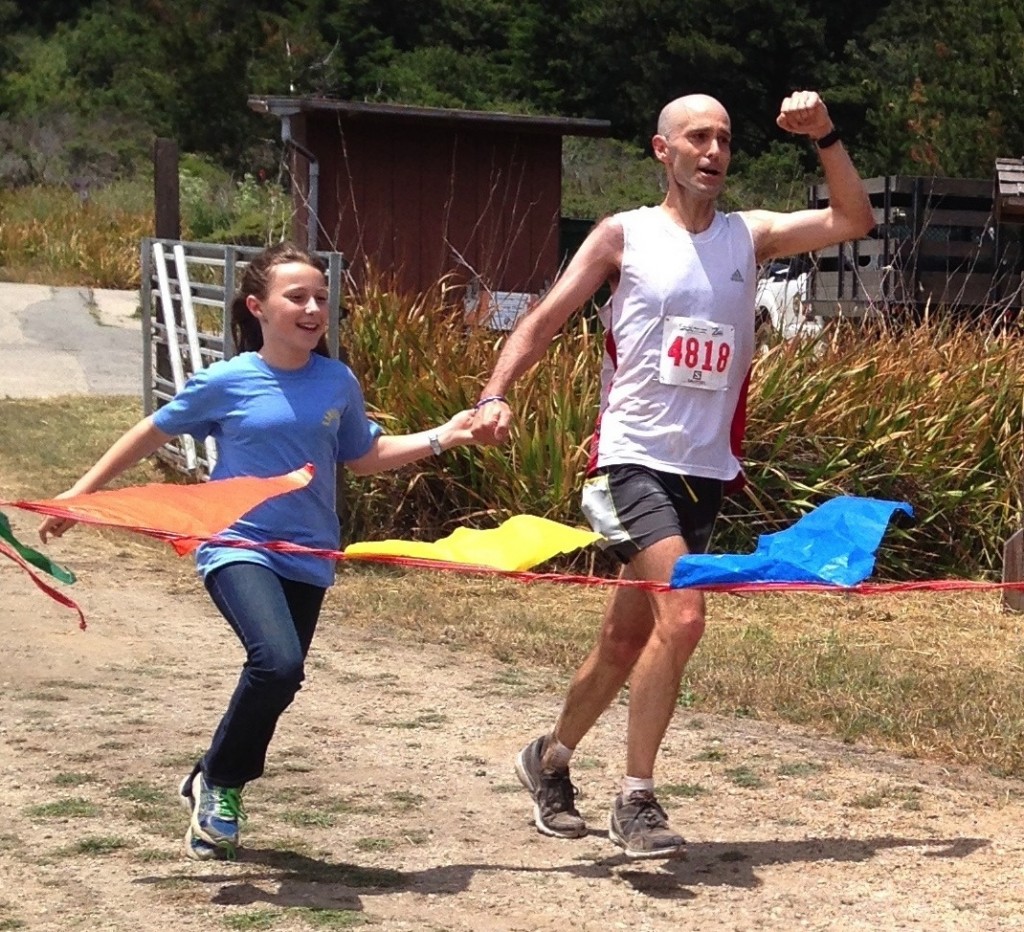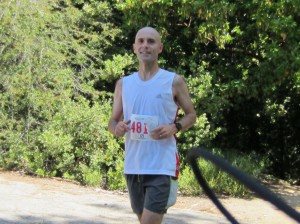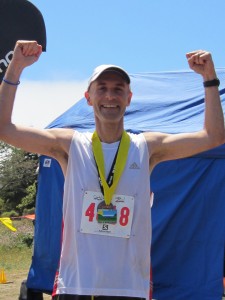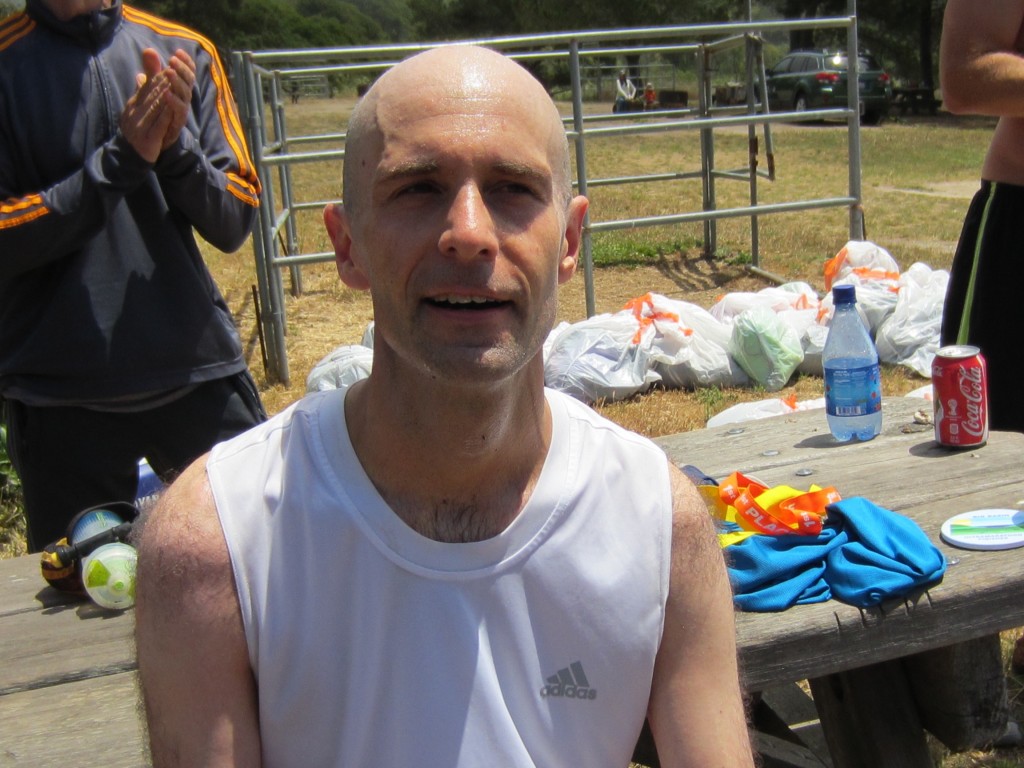
The Skyline to the Sea trail is a gem. Just a few miles from busy Silicon Valley, this trail traverses most of the Santa Cruz Mountain range, 26 miles from the ridge at Saratoga Gap through foggy redwood canyons to the beach at the Pacific Ocean. I’ve hiked it a couple of times as a multi-day backpacking trip, and always wanted to try running it, but the timing was never right or the races were sold out. Then in January I saw Coastal Trail Runs had their Big Basin Skyline to the Sea Trail Marathon scheduled for June, and they still had space available. Yes! I was in.
Beginning in January, I started on a training program to whip my out-of-shape butt back into marathon form. It all went surprisingly well, and I ran several shorter races along the way, including two half marathons, to get myself ready for Skyline to the Sea on June 8. When race weekend finally arrived, I felt fit, healthy, rested, and ready to go.
We arrived at Saratoga Gap about 8:15 for the 9:00 start. Panic struck as I realized I’d forgotten my water belt! Nooooooooo! I took a 20-ounce waist-mounted water bottle on all my long training runs, and had planned to use it on race day during the long dry stretches between aid stations. Instead, I had to beg a used 16 ounce screw-cap disposable bottle from another runner, and carry it in my hands the whole way. I wasn’t happy with that solution, but there wasn’t any alternative.
Coastal Trail Runs organized the race as a marathon concurrently with a 50K, with an extra 5 mile loop for the 50K course. Since everyone was running at least a marathon, it was an athletic crowd. About 300 people squeezed onto the narrow trail at the start, with 175 in the 50K and 125 in the marathon.
Right from the first mile it was HOT! The morning weather in these mountains is normally cool and breezy even in summer, but this day was the hottest day for months, with forecast highs in the mid to high 90’s. The weather data from nearby towns shows it was about 83 at the start of the race, climbing to about 89 in the first 90 minutes. I was uncomfortably warm and beginning to cook. The trail trended downward, but with lots of small ups and downs and twists that demanded concentration. I kept willing myself to slow down and take it easy, but my body started to overheat.
Drinking from the screw-cap disposable bottle was more difficult than I’d expected. Just unscrewing the cap without dropping it while running was tricky, and then the water sloshed and spilled all over the place. I couldn’t squirt it into my mouth like with my normal bottle, and had to stop and walk for a few seconds to drink it down without spilling everywhere. Whenever I did this, two or three people passed me.
I reached the first aid station at Waterman Gap (6.5 miles) at 55 minutes, having averaged about an 8:30 mile pace. The heat had taken its toll, and I felt baked. I spent two or three minutes just lounging at the the aid station, which is something I’ve never done before in any previous marathon. I refilled my bottle, drank three more cups, ate some Shot Bloks, and just caught my breath. I overheard one of the volunteers say something about running low on water, which sounded bad considering there were many more runners behind me yet to come through. Whether the shortage was due to the heat or some logistical error, I don’t know, but it was a bad day to run out of water.
Leaving the aid station, I went into survival mode and just ran easy. I was pretty sure I was headed for a very bad day and lots of walking, so I forgot about racing for a while and just tried to keep moving forward. But a funny thing happened: I started passing people. Maybe they felt even more cooked than I did? The course climbed for a few miles, and many people walked the uphills, but I jogged up them slowly but steadily. Somewhere around mile 10 or so, I started to feel better and caught a second wind. I kept passing people. Many other runners were flagging already.
My GPS watch tracks distance and pace during my runs, but the endless switchbacks and poor reception in the canyons rendered it nearly useless for this race. I didn’t know how far I’d come, or how fast I was moving. And even if I’d known my current pace, how would I have known what pace I should be running? Uphill, downhill, scramble up a rock, come to a complete stop and climb over a fallen tree: it was impossible to keep a consistent speed.
After 1:46 I reached the second aid station at China Grade (11.2 miles), my average pace having now fallen to about 9:30/mile thanks to the climbing. My family was there, and it was all smiles and high fives for a few minutes while I refilled the bottle and wolfed down some food. Water, water, give me water! Once again I stopped at the aid station for several minutes, which seemed like an eternity, but I needed it.

The trail after China Grade was probably the most technically challenging section of the course. We exited the deep shade of the forest and hit a stretch of tilted rock slabs toasting in the sun. Part of it involved running on a side slope on slippery rock, up and down little steps, and through a few bits that were more like climbing than running. Despite my slow pace, I continued to pass other runners. Following this we returned to the forest shade and plunged down a very steep downhill that was like a minefield of roots and rocks and sharp turns. I must have tripped and stumbled at least a dozen times, but managed to catch myself before falling.
Somewhere in the forest around mile 13, while I was trucking down one of these steep rutted sections of trail, my foot landed wrong and I came over my ankle sideways with all my weight on it. There was a sickening CRUNCH and I screamed. But I had so much downhill momentum that I couldn’t stop, and had to hop down the trail on one foot. When I finally stopped, I was sure I’d torn or broken something, and would need an aid crew to help evacuate me to the nearest road. The race was over. But after a minute or two of walking, the initial pain subsided, and the ankle actually didn’t feel too bad. I moved into an easy jog, then within a half mile I’d resumed my former pace. I definitely dodged a bullet there, as I could easily have broken the ankle.
At 2:19 I reached the Gazos Creek Rd aid station at Big Basin Park HQ (mile 15.8). My average pace had improved to about 8:45/mile, so I must have been moving pretty fast considering I walked for several minutes after the ankle injury. My family was there, and I stopped again to exchange high-fives, rehydrate and refuel. I also picked up a second water bottle, knowing that it was a long way to the next aid station and my single 16 ounce bottle wouldn’t be enough. Carrying a water bottle in each hand is like lifting a 1-pound weight with each step. It’s small, but over time the effort adds up, and I could feel an unfamiliar ache in my biceps and shoulders.
The last big climb on the course was just after the aid station, about 500 feet up to the top of the ridge separating Big Basin from the Waddell Creek drainage. I chugged up the hill at my slow and steady pace. By this point the field had thinned out, and I couldn’t see any other runners ahead or behind, but there were lots of hikers on the trail heading to the popular Berry Creek Falls viewpoint. Nearly everyone was good about yielding the trail as I came through, but occasionally it was so narrow that they couldn’t, or I came up behind a hiker so suddenly that they were startled. I wasn’t really moving very fast, though, so pausing for a few moments to squeeze past a hiker didn’t bother me.
Across the ridge, I descended into majestic old-growth redwood forest, nestled into narrow canyons splashed with ferns and moss, with quiet waterfalls whispering at the sides. I was 18 miles into a marathon and hurting, but I grinned ear to ear at the beauty of it all. I can’t imagine a more lovely setting, and at that moment I was grateful to be there, healthy and alive and in the middle of it all. The canyons were filled with cool coastal air, and the temperature dropped from the 80’s into the 70’s or 60’s. Sweet relief!
I think I got passed once here, but also passed one or two people. My brain had floated away somewhere else, and I wasn’t really paying attention or even forming coherent thoughts. The trail went on and on. I passed Berry Creek Falls, a straight drop 65 feet down that’s tucked in between the redwoods and ferns. I crossed a creek several times, and went up and down again and again on little hills by the creek. Most of these were small, but a few were more challenging and one was a very steep uphill – the only place on the course where I walked outside of water stops. I ate more Shot Bloks, stuffed my mouth with raisins and almonds, and kept moving. After the falls, I was completely alone.
Somewhere around mile 21, I finally caught up to two runners. One was tired and walking, but the other still had some gas left. I passed him, then he sped up and passed me back. We’d spoken earlier on the course, and he told me this was not only his first marathon, it was his first race at any distance! He sure picked a tough place to start. We dueled it out for a short while, but eventually I was able to pass him for good. As it turned out, he was the last runner I saw before the finish line.
I bumped along a while longer, not knowing the distance or my pace. I knew I must be in the final 5 miles or so, and it was time to muster whatever energy reserves I had left, so I tried to dial in a hard but manageable level of effort. But with nobody in sight ahead or behind, it was tough to convince myself that an extra 20 seconds or even a minute were really going to matter. I managed something like a tempo run effort, but it wasn’t all-out 100%.
I was now on a mostly flat stretch of fire road in a broadening valley, approaching the coast. My lonely meditation was finally broken by a hiker walking up the road. He cheered me on, and told me I was in 7th place. 7th place! I don’t think I’ve ever been that high in the overall standings before, and the news really lifted my spirits. But it also ignited a fear of being caught from behind, so I turned up the effort level higher.
I reached the Twin Redwoods aid station (24.5 miles) at 3:58 – more than an hour and a half between aid stations! That’s a long, lonely stretch of trail. The volunteers confirmed I was currently 7th, and asked me how I was feeling. I felt surprisingly OK – I was even smiling! I quickly gulped a few cups of water, but didn’t bother to refill my bottle since I had less than two miles left to the finish.
Immediately after the aid station was the final climb on the course. It didn’t look like much on the elevation chart, but coming where it did in the last two miles, it was mean. I pushed up the hill with the best effort I could manage, paranoid that another runner was going to chase me down from behind through this final stretch. The hill wasn’t steep, but it seemed endless. After about a mile of hot and dusty chugging, I came around a bend and was rewarded with a breathtaking vista of the coast plain, the beach, and the ocean waves foaming in the distance. There was still a bit more climbing before the trail finally turned downhill. About 200 yards out, my daughter Alice met me on the trail, and we ran hand-in-hand down to the finish.
Woohoo! I was covered in dirt, bugs, and salt, and my muscles ached, but I felt great! My finish time was 4:14:33. It turned out that one of the runners ahead of me was actually in the 50K (and broke the course record), so I finished 6th place overall in the marathon and 3rd in my division. That was well ahead of my expectations going into the race, and I was thrilled. And that runner chasing me down in the final miles? There was no one. The next person finished several minutes behind.

I relaxed at the finish line for about an hour, chatting with the other runners, cheering as more people finished, and refueling with pretzels and soup. It was a very friendly and relaxed atmosphere, so different from the road mega-marathons I’ve done in the past. The post-race high wore off a bit when I got home and saw that my ankle had swollen up like a grapefruit, but thankfully it didn’t hurt much. With a couple days of rest I’m optimistic that it’ll be ready to resume running again.
Overall I was pleased with the Costal Trail Runs experience. From end to end everything was well organized, and the people were all relaxed and friendly. I really enjoyed the atmosphere at the finish line. It was obvious the Coastal people had hosted these races often enough to have the details nailed. There was only one spot on the course where I thought a turn could have been better marked, but in 26 miles of twisty trails that’s a pretty good record. My only big concern is that I heard some of the aid stations ran out of water for the runners at the back of the pack. Coastal isn’t responsible for the weather, but that’s still a major gaffe and they should have the experience to budget extra water for very hot days.
Before the race, I analyzed the results from past years to an embarrassing degree of detail. I looked for people who’d finished Skyline to the Sea within a couple of months of a flat road marathon or half-marathon, and then attempted to find a formula for predicting finish times. My conclusion was that Skyline to the Sea was 45 minutes to an hour slower than what a runner could achieve on a flat road marathon course. From my race results earlier this spring I’d estimated I was in about 3:25 marathon shape, from which I projected a Skyline to the Sea finish time of 4:10 to 4:20. That proved to be right on the money.
Lessons learned? While this was my slowest marathon by the clock, it was my best ever finish by overall placement or percentile within the overall field. Everybody was cooked by the heat, but I seemed to tolerate it better than most. I’ve never before had the experience of methodically passing so many people in the second half of a marathon. I think I also hydrated more during this race than during any prior marathon, and I definitely took in more calories from food than I’ve ever attempted before. That probably helped stave off the wall in the final miles. This was also the first time I’ve incorporated strength training into my marathon preparation, and I think it helped.
In my past marathons I’ve always been a slave to the clock. If I needed a 7:38/mile average pace to reach my goal, and I had a 7:55 mile split somewhere, I’d freak out and push harder. That kind of clock watching just wasn’t possible in this race, so I went by perceived effort instead. I’m not sure if it worked better or worse, but it certainly felt less stressful, and the results were good. Next time out I’ll definitely try this strategy again.
If you ever have a chance to hike or run Skyline to Sea, grab it! It’s an absolutely gorgeous stretch of trail through nearly untouched wilderness, only an hour’s drive from San Jose and San Francisco. The descent through the redwood canyons to Berry Creek Falls is breathtaking, and deserves a spot on anyone’s bucket list. As a race it was very challenging: steep, twisty, rutted, rocky, and gnarled with huge roots – about as technical as trail races come. But the experience of sailing through fog, ferns, and fairy rings en route to 26 miles of tough accomplishment was worth every step.










